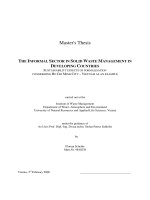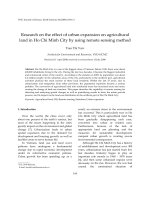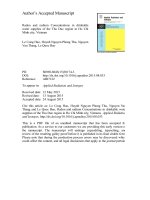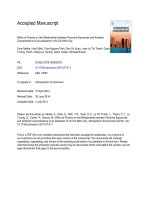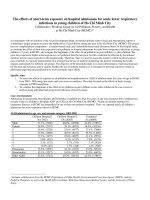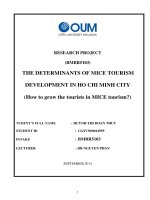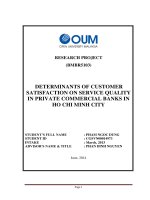The effects of television advertisement on consumer purchasing decision: A case of washing powder industry in Ho Chi Minh city, Vietnam
Bạn đang xem bản rút gọn của tài liệu. Xem và tải ngay bản đầy đủ của tài liệu tại đây (675.13 KB, 13 trang )
The effects of television advertisement on consumer purchasing decision:
A case of washing powder industry in Ho Chi Minh city, Vietnam
Mai Ngoc Khuong
Pham Ngoc Thanh Nha
International University - VNU-HCMC, Vietnam
ABSTRACT
This research attempted to examine the effect of television commercials, as known as TVCs, on customer
purchase decision so as to enhance the effectiveness of advertising via this potential channel and eventually
boost sales for washing powder businesses in Ho Chi Minh city, Vietnam. The research procedure of
quantitative approach was carried out with 314 respondents who purchased washing powder products and
watched TVCs of washing powder products such as OMO, Ariel, Aba, Attack, Tide, Surf, Vi Dan and My Hao.
The outcomes showed that factors of TVCs can positively correlate to customer purchase decision.
Interestingly, customer purchase decision was also found to be affected by customer positive attitudes. As a
result, this study suggested that in order to achieve greater customer purchase decision, TVC producers or
marketers should focus on a) creating a meaningful advertising message b) designing suitable timeline for
TVCs’ repetition c) selecting endorsers who are familiar and trustworthy to the consumers. In addition,
marketers should also pay attention to the factors of interest, credibility and length of TVCs in order to
maximize the indirect effects on purchase decision through customer positive attitudes.
Keywords: Purchase decision, customer positive attitude, TVCs, television commercials
1. Introduction
For ages, brands of the same product that share the same market must always compete severely to get
customers to their side. And television commercials, or TVCs, or broadcasted advertisements via television,
have been one of the most powerful and popular tools to do so. In fact, television watching dominates today’s
leisure activities, with a daily average of 3 to 4 hours reported by past studies (Frey, Benesch & Stutzer, 2007);
hence, advertisements on TV seem to be worthy of investment. TVCs also differentiate over other types of
advertising due to its ability to reach a great number of audiences, make product promotions through sounds
and images, influence customers’ preferences, remind customers about the products or brands, and eventually
increase demand of the goods or services which makes profits for the firm. Moreover, TVC is one of the reliable
and convenient sources for customers to gain information about products and make decisions when shopping.
In particular, 74.3% of the audiences want to buy the new brand introduced in the market after watching TVCs
and 66.3% of them claimed that TVCs help them make a better choice while shopping (Ashaduzzaman & AsifUr-Rahman, 2011).
It is also true for Vietnam, especially Ho Chi Minh city – one of the most populous and active city in the
country. With a population of 8.6 million people (December, 2017) and high proportion of household
433
television, Ho Chi Minh city makes a substantially potential market for TVCs. Knowing that, advertisers in
Vietnam allocated 45% of advertising expenditure on TV advertising, compared to 33% on print ads and the
rest on outdoor and radio ads. And the amount of funding for this channel accounted for $800 billion in 2013
and is expected to increase significantly over years up to 2018 (Nguyen, 2018).
According to the Consumer Buying Process (Jones, 2014), ‘Purchasing decision’ is the last stage prior
‘Purchase’. Purchasing decision, on the other hand, is claimed to be influenced by external factors such as
advertisements during the stage of Gathering information (Nguyen, 2018). Therefore, companies must gain as
much purchase decision from customers as possible to gain success in sale and to maximize their profits. This
once again emphasizes the importance of companies advertising effectively via television.
2. Literature Review
2.1. Customer Purchase Decision
The term consumer decision generates an image of an individual who is evaluating all the attributes of the
products or brands and rationally choosing one to satisfy their need for the minimum cost. Many internal and
external factors affect consumers’ purchase decisions, which makes consumer purchase process a complicated
matter. There are 5 stages in the process of decision making of customers: needs or problems recognition,
information search, evaluation of alternatives, decision making, and evaluation of the decision made
(Solomon, Dahl, White, Zaichkowsky & Polegato, 2014).
In other words, to make purchase decision, customers may undertake various forms of search and obtain
information from many sources including internal sources and external sources. Internal sources refer to the
mental process of researching by memory and experience, which may serve as a basis for the decision process.
External sources refer to references such as personal family, friends or acquaintances; advertising such as
commercials, sales persons, dealers, displays; mass media; and experiential such as handling, examining,
trying goods or services (Munthiu, 2009).
Knowing this, companies spend billions of dollar every year investigating various influences and
understanding how consumers make decisions to buy products (Solomon, Dahl, White, Zaichkowsky, &
Polegato, 2014). There are actually many factors which affect customer purchase decision, generalized into
three categories namely Cultural factors, Social factors, Personal factors, Psychological factors (Hussain, 2017).
It is impossible to take control of all these factors; however, marketers have taken into account several of
them. For example, up to now, firms have been trying several methods to do so, from deeply scientific research
such as looking at people’s brains to practical practices such as gathering customers’ information, tracking
Web patterns, tracking positions and studying people’s habits to develop and send them suitable ads
(Solomon, Dahl, White, Zaichkowsky, & Polegato, 2014).
2.2. Customer Positive Attitude
Attitude is simply referred as any knowledge or feelings, either positive or negative, about an object or an
activity. Attitude can also be, in a more academic definition, ‘an enduring organization of motivational,
emotional, perceptual and cognitive processes with respect to some aspect of our environment’ (Carvalho,
2013).
Attitude can be used as a measurement, or an overall evaluation of how a person like or dislike an object,
an issue, a person or an action. Meanwhile, attitude toward the behavior can be seen as ‘a person’s general
feeling of favorableness or unfavorable-ness for that behavior’ (Carvalho, 2013).
Many past research has tried to look into the formation of attitude, where they found consumer attitude
consists of cognitive component (knowledge and leering) and affective component (feelings and emotions).
434
These two components are found to link with conative component (tendency, intention or inclination).
Specifically, conative component is defined as the intent or action component. This intent refers to the
likelihood of brand purchase with measures of behavioral intent, such as intention to search for information
or purchase intention. This component also refers to the consumer’s action toward the brand: trial, purchase,
adoption, or rejection (Carvalho, 2013).
With these three components, attitudes of consumers can be positive in many cases. For example, Internet
advertising seems to generate positive consumer attitudes because Internet advertising is often thought to be
informative and entertaining (Tsang, Ho, & Liang, 2004). At the same time, attitudes can also be negative. In
fact, studies after 1970 provided evidences of the unfavorable public attitude toward advertising. In particular,
one study found that a majority of viewers regarded TV advertising to be seriously misleading (Schlosser,
Shavitt, & Kanfer, 1999).
In addition, attitudes tend to be enduring and not likely to change since they are based on people’s values
and beliefs. However, regardless of that characteristic, companies would want their consumers to have
positive attitudes rather than negative ones about their offerings (Solomon, Dahl, White, Zaichkowsky &
Polegato, 2014).
According to the findings of Isen (1993), consumers who are having positive feelings such as: happiness,
joy, delight, relaxation, inspiration, etc. tend to perceive the television advertisements with pleasure and to
have better recall of the advertising message as well as the product feature.
Yielding similar results, the author of Schwarz (2001) found that people would send a positive
recommendation back if they have comfortable feelings about the target object. Good feelings also partly push
consumers’ persuasion as they boost positive thinking, which makes consumer make more impulsive
decisions (Schwarz, 2001; Gardner, 1985). In contrast, customers who are having negative emotions tend to
engage themselves in the behaviors of switching brands (Roos, 1999).
From all the above, customer positive attitude can be seen as a considerably crucial factor in the process of
purchase decision making of customers. Advertisers should take it into account in order to create such TVCs
which can receive positive attitudes from viewers; in other words, they may have succeeded half-way in
enhancing customer purchase decision.
2.3. Credibility
Credibility depicts a person’s perception of how true a piece of information or news is. It serves as a means
for the information receiver to rate the source or transmitter of the communication involved. In the case of
marketing communication, a company or its representatives are the sources while the consumers are the
receivers (Eisend, 2006).
Credibility has been of particular interest of plenty of marketers because it is believed to have impact on
the attitudes, intentions and behaviors of the information receivers. Given the knowledge of a robust
relationship between attitudes and upcoming behaviors, it is noticeably important for source credibility to be
as persuasive as possible (Eisend, 2006).
In initial source credibility research, dimensions of credibility were highlighted, namely competence
(‘competence’, ‘expertise’, ‘expertness’, ‘knowledge ability’, ‘qualification’, ‘smart dimension’) and
trustworthiness ('trustworthiness', 'character', 'personal integrity') (Hovland, Janis & Kelley, 1953; Hovland &
Weiss, 1951).
Moreover, the study of Soh, Reid and King (2009) concluded the combination of ‘consumer perception of
reliability and usefulness of advertising’, ‘consumer affect toward advertising’, and ‘consumer willingness to
rely on advertising for decision making’. Therefore, the advertisement will be able to introduce the products
to consumers only when it can generate trustworthiness in their mind.
435
2.4. Interest
Interest refers to one’s personal feelings towards a certain brand or a certain type of product advertised
(Hosein, 2012). In other word, interest can be a person’s favorite objects like a book or a movie; and activities
like playing a certain sport or listening to a certain genre of music. Past studies also showed that consumers
might become interested in acquiring more information after they have become aware of the brand, products
or services offered by a company which appear attractive to them (De Bruyn & Lilien, 2008).
However, whether customer would purchase the product or not, interest simply illustrates that person’s
liking, or positive feeling, about that brand or product (Hosein, 2012).
On the basis of daily life, several studies have found a direct relationship between customers’ interest and
their purchase behavior. Specifically, most customers would have limited budget for purchasing goods and
services, which makes them majorly depend on their interest to buy and consume the products. Furthermore,
customers’ interest can be used as an effective predictor of customer purchase behaviors (Yildiz & Dempski,
2012).
One past survey studying 425 people also showed that the factor of interest was the most influential one
that can lead to intention and purchase (Karthikeyan & Balamurugan, 2012).
2.5. Length
The length of TVC is the duration of time, usually in second, of which the advertisement was broadcasted
on TV. Two typical length for commercial are 15 seconds and 30 seconds (these two are popular since they can
be easily distributed via other channels like YouTube, radio). At present time, there are more various lengths
possible to one commercial: 5-second (YouTube), from 3-5 minutes (via a music video) or even longer (in the
means of a short story-movie).
It is obvious that a too short commercial may be insufficient to retain itself in the audiences’ or consumers’
mind; however, if the ad is too long, people would become bored and switch channels to skip the commercial.
According to Fabian’s (1986) research, there was a noticeable positive relationship between the length of a
commercial and its advertising effectiveness. The audience can be allowed with more change to attend to the
TVC given a suitable ad length, which means consumers can learn and understand advertising message as
well as the product information in the most effective manners. A suitable length of the commercial is also
believed to have better ad recall efficiency since it partly eliminates the wear-out phenomenon which is often
experienced when the ad is too long and the audiences get tired of the ad.
In other the words, consumers need to see a commercial made with a fine length. Therefore, depending on
the purpose of the advertising campaign and the target customers, advertisers should choose the appropriate
length.
2.6. Endorsers
One of the well-known strategies to promote a product is to use advertising endorsers. An endorser can be
defined as an individual that supports and recommends to the audiences some certain products, services,
brands and behaviors (Stafford, Stafford and Day, 2002; Roozen, 2008).
Endorsers are classified into three principal categories: celebrities, experts and typical consumers (Wang,
Tokarz & Savage-Dunn, 2002). The term ‘celebrity endorser’ refers to a person who enjoys public recognition
and utilize that recognition to appear in an advertisement with a product on behalf of it. Using celebrities
yields a potential benefit of catching attention of the audiences; however, it also has a higher risk of negative
reputation or unwanted scandals related to the personal life of the celebrity (McCracken, 1989; Phan, 2013).
Meanwhile, an expertise endorser can be described as a person who possesses superior and professional
knowledge about the product (Friedman & Friedman, 1979). They are believed to have credible information
436
which is truly helpful to solve the consumer’s problem (Ohanian, 1990). Finally, a typical consumer endorser
can be understood as an ordinary person with no prior knowledge of the product. This type of endorsement
is meant to reflect the typical experiences and feelings of consumers (Friedman & Friedman, 1979).
Each type is believed to play an effective role in various product segments (Wang, Tokarz & Savage-Dunn,
2002). For instance, celebrities can often be found to promote products bearing high social risk such as jewelry
or cars. Experts, on the other hand, are suitable for introducing high-performance products such as medicine
and professional appliances. And typical consumers are effective in advertising daily use products such food,
beverage or FMCG (Khuong & Nguyen, 2014).
To examine the relative effectiveness of an endorser, CATLEF model is used, which includes 6 variables:
Credibility (C), Attractiveness (A), Trustworthiness (T), Likeability (L), Expertise (E) and Familiarity (F)
(Roozen, 2008).
2.7. Advertising Message
The advertising message can be simply understood as ‘anything’ the brand, the product or the company is
trying to convey through the advertisement to the consumers, namely the name, logo, slogan, the features of
the product, etc. It can also be a brief and simple yet catchy slogan, or the touching and meaningful long-whole
story that reflects the identity of the product of the brand.
A good message can easily lead to a good advertisement. In other words, advertising message can be
defined “as a dominating theme of an ad that motivates consumers to remember the advertisement and
purchase the product in the advertisement” (Mueller, 1987).
Past research proposed two types of message: positively framed message and negatively framed message
(Grewal, Gotlieb & Marmorstein, 1994). Positively framed messages are defined as communications that
emphasize a brand’s advantages or the potential gains to consumers in a situation. In contrast, the reversed
definition is true for negatively framed messages. Advertisers would often prefer if their advertisement
conveys positively framed messages.
According to the research of Sofi and Nika (2013), the messages of ads have an impact on customer
purchase behavior. For example, logo can easily be remembered by customers if it is really impressive while
slogan can attract customers and can make the product differentiate from others.
2.8. Repetition
Repetition of advertising is an act of displaying of the ad and letting the audiences watch it more than once
(Khuong & Nguyen, 2014).
Various attempts to understand the effectiveness of repetition have been made in marketing. One can
simply understand, that increasing exposure to advertisement can result in increasing memory; however,
seeing advertisement for too many times would affect negatively to consumer as they may feel irritating and
intrusive. Thus, decision on the repetition of the adverts, accompanied by other decisions like the scheduling
of advertisements, the number of different advertisements to produce and customer’s pretesting of
advertisements, should be carefully evaluated.
Research showed that the advertisement repetition also has a significant effect on purchase decision of
consumers (Majeed & Razzak, 2011). Specifically, the first display of television advertisement raises the
curiosity, the second time leads to an evaluation and in the third time customer decide whether to purchase
product or not (Krugman, 2000). It was also found the one to three times of repetition are enough for
purchasing (Vakratsas & Ambler, 1999).
According to all the dependent and independent factors above, this study proposes the following
Hypotheses:
H1: Factors of TVCs positively affect Customer Positive Attitudes.
437
H2: Factors of TVCs and Customer Positive Attitude positively affect Customer Purchase Decision.
H3: The effects of Factors of TVCs on Customer Purchase Decision are mediated by Customer Positive
Attitude.
3. Methodology
3.1. Research Design and Data Collection
The focus of this study is to determine which factors have an impact on customer purchase decision. The
main method employed to collect data and examine the effects between variables is the Quantitative approach.
Questionnaire was built for the survey, which was designed in the form of print handouts to distribute offline
and Google Form to distribute online. Most of the questions included were based on five-point Likert scale
which require respondents to rate the given items on the scale of five points from ‘1’ indicating ‘strongly
disagree’ and ‘5’ indicating ‘strongly agree’.
Target audiences of this survey are the target customers of washing powder products namely OMO, Ariel,
Aba, Attack, Tide, Surf, Vi Dan and My Hao. In this case, the respondents chosen will be female customers,
aged from 18 to 60+, living in Ho Chi Minh city. Convenience sampling was applied and carried out at private
households where housewives were interviewed and public places such as universities, offices and coffee
shops where female adults were surveyed. In the end, the sample population collected was 314 respondents,
which is a suitable size according to Comrey & Lee (1992).
3.2. Factor Analysis and Reliability Test
Two Exploratory Factor Analyses (EFA) were carried out for two groups of variables, one group of 7
independent variables and one group of 2 dependent variables. The principal component extraction method
and varimax rotation were conducted to determine the relationship among variables. Descriptive Statistics were
also used to illustrate the demographic data as well as other variables in the research model. Moreover,
Multiple Regressions were utilized to find out the impacts of the independent variables (music, credibility,
endorsers, interest, advertising message, repetition, length) on the dependent variables (customer positive
attitude, customer purchase decision).
The results of EFAs indicate that the Kaiser-Meyer-Olkin (KMO) measure of sampling adequacy was 0.857
for the independent variables and 0.855 for the dependent variables. According to Tababachnick & Fidell, the
KMO index ranges from 0 to 1 and the minimum value for an acceptable factor analysis is 0.6, which means
the data collected was suitable for further analysis.
At the same time, the Bartlett’s Test was conducted and the factor analysis was considered appropriate
when significant ≤ 0.05 (Tababachnick & Fidell).
TABLE I: SUMMARY OF INDEPENDENT VARIABLES
Given Names
Number of Items
Cronbach’s Alpha
1. Credibility (CR)
4
.850
2. Interest (INT)
4
.826
3. Length (LEN)
3
.763
4. Endorsers (ENDO)
5
.777
5. Advertising Message (MES)
5
.811
6. Repetition (REP)
3
.749
7. Music (MU)
5
.802
438
As provided by the study, there were 7 components extracted and all the Eigenvalues are greater than 1
(the minimum value is 1.207). Furthermore, the extraction sums of squared loadings equal to 63.502 which is
greater than 50%. This means these 8 factors account for 63.502% of data variance indicating good reliability
of these variables. Additionally, the Cronbach’s coefficients range from 0.749 to 0.850 illustrating the internal
consistency of these variables as shown in ‘Table I’.
TABLE II: SUMMARY OF DEPENDENT VARIABLES
Given Names
Number of Items
Cronbach’s Alpha
1. Customer Positive Attitude (CUPOAT)
6
.820
2. Customer Purchase Decision (CUPUDE)
4
.808
Similarly, two dependent factors make up 57.911% of the total variance and both Eigenvalues values are
also greater than 1 (with smallest is 1.034). Their Cronbach’s alphas are also demonstrated in ‘Table II’.
4. Results and Discussions
4.1. Profile of Consumers involved in the study
TABLE III: DEMOGRAPHICS OF PARTICIPANTS
Gender
- Female
- Male
Total
Age
- 18-25
- 25-35
- 35-45
- 45-60
- Over 60
Total
Relationship Status
- Single
- Married
Total
Education Level
- High School
- College
- University
- Vocational Education
- Post-graduate
Total
Monthly Income
- Below 2 million VND
- 2-6 million VND
- 6-10 million VND
- 10-20 million VND
- Over 20 million VND
Total
439
Frequency
Percent
314
0
314
100.0
0.0
100.0
106
110
48
21
29
314
33.8
35.0
15.3
6.7
9.2
100.0
147
167
314
46.8
53.2
100.0
83
22
191
7
11
314
26.4
7.0
60.8
2.2
3.5
100.0
58
128
99
24
5
314
18.5
40.8
31.5
7.6
1.6
100.0
4.2. Correlations between Factors of TVC and Customer Purchase Decision
Pearson Product-moment Correlation Coefficients (R) are applied to illustrate the relationship
between Factors of TVC and Customer Purchase Decision.
TABLE IV: CORRELATION AMONG VARIABLES
1. MES
2. ENDO
3. CRE
4. MUS
5. INT
6. LEN
7. REP
8.CUPOAT
Mean
SD
CUPUDE
1
2
3
4
5
6
7
8
.522*
.504*
.358*
.132*
.510*
.287*
.517*
.642*
3.37
.68
.499*
.513*
.287*
.482*
.342*
.406*
.582*
3.67
.62
.501*
.251*
.542*
.236*
.405*
.517*
3.17
.64
.289*
.388*
.248*
.285*
.492*
3.33
.71
.256*
.243*
.168*
.210*
4.05
.64
.297*
.432*
.598*
3.02
.74
.342*
.373*
3.70
.62
.471*
3.43
.72
3.29
.66
*. Correlation is significant at 0.005 level (one-tailed)
As can be seen in ‘Table IV’, there are positive and significant relationships between all independent
variables and the dependent CUPUDE, where: MES (R= .522, p <.005); ENDO (R= .504, p <.005); CRE (R= .358;
p <.005); MUS (R= .132; p <.005); INT (R= .510; p <.005); LEN (R= .287; p <.005); REP (R= .517; p <.005); and
CUPOAT (R= .642; p <.005). Therefore, if MES, ENDO, CRE, MUS, INT, LEN, REP or CUPOAT increases,
Customer Purchase decision would increase.
This study discovered that CUPUDE could be affected by independent components in two ways: direct
and indirect. Direct impacts can be observed through the unstandardized regression coefficient (β) and
illustrated in the path model. Meanwhile, indirect impacts of independent factors on CUPUDE can be
calculated by the product of the effects of independent variables on the mediating variable and the effect of
the mediating variable on the dependent variable.
4.3. Direct Effects on Customer Purchase Decision
The first multiple regression, which tested Hypothesis 2 (H2), revealed that 51.5% of the variance in
CUPUDE could be explained by MES, ENDO, CRE, MUS, INT, LEN, REP and CUPOAT as independent
variables of the model. In particular, CUPUDE is majorly predicted and affected by four critical predictors:
MES (β = .172, p < .05); ENDO (β =.160, p < .05); and REP (β =.205, p < .05). Additionally, CUPUDE is also
noticeably affected by CUPOAT (β =.379; p < .05), which means Advertising Message, Credibility, Interest,
Length, and Repetition of the TVCs can provide indirect effects on Customer Purchase Decision through the
mediating of Customer Positive Attitude.
4.4. Indirect Effects of TVC on Customer Purchase Decision
The indirect effect of an independent variable on a dependent one mediated by a mediating variable can
be calculated by multiplying the effect of the independent variable on the mediating variable with the effect
of the mediating variable on the dependent variable [40].
The second multiple regression that tested Hypothesis 1 (H1) showed that 53.3% of the variance of
CUPOAT could be explained by MES, ENDO, CRE, MUS, INT, LEN and REP as independent variables of the
model. In particular, CUPOAT was mainly influenced by five predictors: MES (β = .249, p < .05); CRE (β =.150,
p < .05); INT (β =.262, p < .05); LEN (β =.118, p < .05); and REP (β =.126, p < .05). Therefore, through the
440
intervening of Customer Positive Attitude, the result indicated that Customer Purchase Decision can be
indirectly affected by Advertising Message, Credibility, Interest, Length and Repetition of the TVCs.
4.5. Path diagram of Customer Purchase Decision
Figure 1: Path diagram of customer purchase decision
Note: All coefficients were significant at .05 level.
4.6. Significance of Indirect Effects
TABLE V: DIRECT AND INDIRECT EFFECTS
Variables
Casual Effects
LL
UL
Direct
Indirect
Total
MES
.172
.094
.266
.0542
.1389
CRE
INT
-------
.057
.099
.057
.099
.0265
.0631
.0910
.1396
LEN
----
.045
.045
.0147
.0783
REP
ENDO
.205
.160
.048
----
.253
.160
.0204
.0784
CUPOAT
.379
----
.379
.916
.343
1.259
The study utilized the bootstrapping method in order to test the significance of the indirect effects or
mediations, as recommended by Preacher and Hayes (2008), and the bootstrapped confidence intervals are at
the 95%. If there is a zero (0) within the interval range between the lower level for confidence interval (LL) and
the upper level for confidence interval (UL), with 95% confidence, there is no mediation or indirect effect. In
contrast, if zero does not lie in the range of LL and UL, we can conclude that, with 95% confidence, the
mediation or indirect effect is significant (Preacher & Hayes, 2004).
441
The outcomes are shown in “Table V”: The indirect effect of MES through the mediation of CUPOAT is
between .0542 (LL) and .1389 (UL); that for CRE is from .0265 to .0910, for INT is from .0631 to .1396, for LEN
is from .0147 to .0783, and for is from .0204 to .0784. Therefore, we can conclude that the indirect effects of
MES, CRE, INT, LEN and REP on CUPUDE are obviously different from zero at p < .05 (two tailed) and the
mediation of CUPOAT of this study is true.
The total effects of independent variables on customer purchase decision are 1.219; in particular, the direct
effects by CUPOAT, MES, REP and ENDO account for 72.8% while the indirect effects by MES, CRE, INT,
LEN and REP account for 27.2%.
4.7. Discussion and Recommendation
The study aimed to determine which factors of TVCs can have an impact on Customer Positive Attitude
(CUPOAT) and Customer Purchase Decision (CUPUDE) in order to provide efficient recommendations on
how to produce effective TVCs. In particular, seven independent factors of TVC which are Advertising
Message (MES), Credibility (CRE), Interest (INT), Length (LEN), Repetition (REP), Endorsers (ENDO) were
analyzed, which revealed both similar and distinct results compared to several past studies.
On the one hand, the results showed that only three of these factors which are REP, MES and ENDO (in
accordance of more significant effect) were proven to have direct impacts on CUPUDE. Firstly, REP directly
affects CUPUDE, quite similar the outcome of Majeed and Razzak (2011) and Turley and Shannon (2000).
Thus, TVCs should be broadcasted with an appropriate number of times, recommended to be shown in prime
time during the day so as to gain more views as well as to avoid “wear out” effects (Khuong & Nguyen, 2014),
and Pechmann and Stewart (1988) recommended). Secondly, the significant direct effects of MES on CUPUDE
are quite similar to the proven results of Sofi and Nika (2013), as well as of Maheswaran and Meyers-Levy
(1990). Therefore, TVC producers should carefully take MES into account, which means creating a meaningful,
unique, attractive, understandable and truthful one, in order to influence more customers in deciding what to
buy. Finally, ENDO can also place certain impacts on CUPUDE, much the same results proven by past
researches namely Sallam and Wahid (2012), and Chi, Yeh and Tsai (2011) but opposite to that of Khuong and
Nguyen, (2014). TVC producers, hence, should choose Endorsers, whether they are celebrities or not, while
considering their familiarity, trustworthiness, expertise, loveliness and credibility.
At the same time, the indirect effects of five factors of TVC which are MES, CRE, INT, LEN and REP through
CUPOAT on CUPUDE were also confirmed in this study. In particular, CUPOAT was quite similarly proven
in previous studies to have direct impacts on CUPUDE such as in the studies of Sallam and Wahid (2012), Anh
(2014), Yang, Al-Shaaban (2014), Khuong and Nguyen (2014) which was more clearly verified in this study.
Following that, this study also showed that CUPOAT turned out to have the strongest association among
factors affecting CUPUDE.
Subsequently in this study, INT does not have direct effect on CUPUDE, in contrast to Fabian’s (1986), but
have indirect effects mediated by CUPOAT, quite similar to Khuong and Nguyen’s (2014). As this factor
asserts the most indirect effect, TVC producers should conduct market research on what type of TVC
customers love watching so that they can have positive attitude and their purchase decision can be influenced.
This is also true for the factors of CRE and LEN which only have influences on CUPUDE via CUPOAT.
Previous researches recommended in more details that long advertisement which lasts 30 seconds had greater
impacts than short advertisement that is only 15 seconds (Khuong & Nguyen, 2014; Jeong, 2007). Credibility
of TVC should also be enhanced in terms of honesty, credibility, reliability and dependability so that customer
attitude can become positive towards the advertised products and eventually decide to buy the product,
similarly to Kim, Ferrin and Rao (2009).
Other than the three indirect effects of INT, CRE and LEN, two factors of MES and REP have both direct
effect (as stated above) and quite significant indirect effect on CUPUDE, with Anh (2014) yielding quite similar
442
outcomes. Thus, to “kill two birds with one stone”, TVCs should be made with strong advertising messages
and broadcasted with appropriate frequency.
6. Conclusion
The main purpose of this study is to find out which factors of a television advertisement can affect
Customer Purchase Decision.
The research applied multivariate statistical methods including Factor Analysis, Standard Multiple
Regression and Path Analysis to analyze the positive relationships among variables in the model of Customer
Purchase Decision proposed. Explanations and recommendations were based closely on empirical findings of
the study. Regarding correlations among variables, bivariate correlations and Pearson product-moment
correlation coefficients were utilized to test the significance of the relationships between each independent
variable and dependent ones. These were also applied for the relation of mediating variable with other
variables.
In the end, results acquired show that there are four independent variables have direct effects on purchase
decision: Customer Positive Attitude towards TVCs, Advertising Message of TVCs, Repetition of TVCs and
Endorsers in TVCs. Meanwhile, there are five variables having direct effects on Customer Positive Attitude:
Advertising Message of TVCs, Credibility of TVCs, Interest in TVCs, Length of TVCs and Repetition of TVCs.
And as mentioned above, Customer Positive Attitude has a significant direct effects on Customer Purchase
Decision which eventually results in indirect effects of the five variables above on purchase decision.
Based on these results, TVCs can be looked closely at and, as a result, TVC producers can acknowledge
which factors to focus on to gain their final goal of purchase decision, which also helps them to save costs in
TVC production.
In terms of limitations, firstly, factors of TVCs examined in this study were limited to only a list of seven.
There are many other factors of TVCs in need of researching to provide a full perspective of customer decision
and attitude.
Secondly, this study was conducted over a quite short period of time. In other words, it was difficult to
take into new and current trends and quite likely to become obsolete over time.
Finally, the procedure of data collection was carefully controlled and involved the sample of 314
respondents who are target customer of washing powder products and live in Ho Chi Minh city, Vietnam. In
other words, this study should be applied mainly for Vietnam market, specifically the washing powder
industry.
Therefore, future research need to take into account of all three limitations above as a stepping stone so as
to avoid common pitfalls in researching or to expand research in a wider and more interesting direction to
provide a more generalized outcome that can be applied in all markets and in any circumstances.
References
Anh, V. D. L. (2014). The impacts of television advertisement of TH true milk on consumer buying behavior (Master thesis, International
University HCMC, Vietnam).
Ashaduzzaman, M., & Asif-Ur-Rahman, S. M. (2011). Impact of Television Advertisements on buying pattern of Women in Dhaka
City. European Journal of Business and management, 3(3), 16-22.
Carvalho, C. A. (2013). Impact of consumer attitude in predicting purchasing behaviour. A paper available at< http://iaso. com.
br/pdf/Impact% 20of% 20Consumer% 20Attitude% 20in% 20Predicting% 20Purchase% 20Behaviour. pdf>, accessed on 18th of
December.
Chi, H., Yeh, H. R., & Tsai, Y. C. (2011). The influences of perceived value on consumer purchase intention: the moderating effect of
advertising endorser. Journal of International Management Studies, 6(1), 1-6.
Comrey, A. L., & Lee, H. B. (1992). A first course in factor analysis (2nd ed.). Hillsdale, NJ: Erlbaum
De Bruyn, A., & Lilien, G. L. (2008). A multi-stage model of word-of-mouth influence through viral marketing. International Journal of
Research in Marketing, 25(3), 151-163.
443
Eisend, M. (2006). Source credibility dimensions in marketing communication–A generalized solution. Journal of Empirical Generalisations
in Marketing Science, 10(2).
E. Yildiz and K. Dempski. (2012). An Interest-based Approach for Content Personalization. [Online]. Available:
/>Fabian, G. S. (1986). 15-second commercials: the inevitable evolution. Journal of Advertising Research, 26(4), RC3-RC5.
Frey, B. S., Benesch, C., & Stutzer, A. (2007). Does watching TV make us happy?. Journal of Economic psychology, 28(3), 283-313.
Friedman, H. H., & Friedman, L. (1979). Endorser effectiveness by product type. Journal of advertising research, 19(5), 63-71.
Gardner, M. P. (1985). Mood states and consumer behavior: A critical review. Journal of Consumer research, 12(3), 281-300.
Grewal, D., Gotlieb, J., & Marmorstein, H. (1994). The moderating effects of message framing and source credibility on the price-perceived
risk relationship. Journal of consumer research, 21(1), 145-153.
Hosein, N. Z. (2012). Measuring the purchase intention of visitors to the auto show. Journal of management and marketing research, 10, 1.
Hovland, Carl I.; Janis, Irving L.; Kelley, Harold H. (1953) Communication and Persuasion. Psychological Studies of Opinion Change,
Yale University Press: New Haven, CO.
Hovland, Carl I.; Weiss, Walter (1951) "The Influence of Source Credibility on Communication Effectiveness", Public Opinion Quarterly,
15(1), p.635-650.
Hussain, M. (2017). Study on Consumer Decision Making process in the Selection of Home Cleaning Company: Case Company: MHB
Clean Helsinki.
Jeong, Y. (2007). The effectiveness of the length of commercials in different types of television programs. The University of North Carolina
at Chapel Hill.
Karthikeyan, N., & Balamurugan, T. (2012). Mobile Marketing: Examining the impact of Interest, Individual attention, Problem faced and
consumer’s attitude on intention to purchase. Interdisciplinary Journal of Contemporary Research in Business, 3(10), 809-821.
Kim, D. J., Ferrin, D. L., & Rao, H. R. (2009). Trust and satisfaction, two stepping stones for successful e-commerce relationships: A
longitudinal exploration. Information systems research, 20(2), 237-257.
Krugman, H. E. (2000). Memory without recall, exposure without perception. Journal of Advertising Research, 40(6), 49-54.
Khuong, M. N & Nguyen, T. D. (2014). The Effects of Television Commercials on Customers Purchase Intention – A Study of Milk Industry
in Ho Chi Minh City, Vietnam. Journal of Economics, Business and Management, 3(9), 851-857.
Maheswaran, D., & Meyers-Levy, J. (1990). The influence of message framing and issue involvement. Journal of Marketing research, 361367.
Majeed, S., & Razzak, S. (2011). The impact of television advertisement repetition, celebrity endorsement and perceived quality on
consumer purchase decision. Australian journal of basic and applied sciences, 5(12), 3044-3051.
McCracken, G. (1989). Who is the celebrity endorser? Cultural foundations of the endorsement process. Journal of Consumer Research,
16(3):310-21.
M. Isen, “Positive affect and decision making,” in Handbook of Emotion, ed., M. Luis and G. M. Haviland eds., New York: Guilford, 1993
Mueller, B., (1987). Reflections of culture: An analysis of Japanese and American advertising appeals. Journal of Advertising Research, 27(3),
51-59.
Munthiu, M. C. (2009). The Buying Decision Process and Types of Buying Decision Behavior. Sibiu Alma Mater University Journals. Series
A. Economic Sciences, 2(4), 27-33.
Nguyen, H. (2018). Advertising in Vietnam.Retrieved from:
/>Ohanian, R. (1990) Construction and validation of a scale to measure celebrity endorsers perceived expertise, trustworthiness, and
attractiveness. Journal of Advertising, 19(3), pp. 39–52
Pechmann, C., & Stewart, D. W. (1988). Advertising repetition: A critical review of wearin and wearout. Current issues and research in
advertising, 11(1-2), 285-329.
Phan Thi Thuong (2013). Market research about the influence of using Expertise endorser in TVC on consumer's attitude: The case of
Colgate TVC (Master thesis, International University HCMC, Vietnam).
Preacher, K. J., & Hayes, A. F. (2008). Asymptotic and resampling strategies for assessing and comparing indirect effects in multiple
mediator models. Behavior research methods, 40(3), 879-891.
Preacher, K. J., & Hayes, A. F. (2004). SPSS and SAS procedures for estimating indirect effects in simple mediation models. Behavior research
methods, instruments, & computers, 36(4), 717-731.
Roos, (August 1999). Switching processes in customer relationships. Journal of Service Research. [Online]. 2(1). pp. 376-393. Available:
/>Roozen, I. (2008). The relative effectiveness of celebrity endorsement for beauty, high-and low involvement product print advertisements.
7th International Congress" Marketing Trends".
Sallam, M. A. A., & Wahid, N. A. (2012). Endorser credibility effects on Yemeni male consumer’s attitudes towards advertising, brand
attitude and purchase intention: The mediating role of attitude toward brand. International Business Research, 5(4), 55.
Schlosser, A. E., Shavitt, S., & Kanfer, A. (1999). Survey of Internet users’ attitudes toward Internet advertising. Journal of interactive
marketing, 13(3), 34-54.
Schwarz, N. (2001). Feelings as information: Implications for affective influences on information processing. Theories of mood and
cognition: A user's guidebook, 159-176.
Soh, H., Reid, L. N., & King, K. W. (2009). Measuring trust in advertising. Journal of Advertising, 38(2), 83-104.
Sofi, S. A., & Nika, F. A. (2013). Impact of Subliminal Messages in TV Advertisements on Customer Behaviour (A Case Study of Youth in
Kashmir Province of J&K). Journal of Business Management & Social Sciences Research, 2, 12.
Solomon, M. R., Dahl, D. W., White, K., Zaichkowsky, J. L., & Polegato, R. (2014). Buying Decision Process of Consumer, Consumer behavior:
Buying, having, and being (Vol.10). Pearson.
Solomon, M. R., Dahl, D. W., White, K., Zaichkowsky, J. L., & Polegato, R. (2014). Consumer Behavior: How People Make Buying
Decisions, Consumer behavior: Buying, having, and being (Vol.10). Pearson.
Stafford, M. R., Stafford, T. F., & Day, E. (2002). A contingency approach: The effects of spokesperson type and service type on service
advertising perceptions. Journal of Advertising, 31(2), 17-36.
444
Tababachnick and L. S. Fidell, (1996). “Task force on statistical inference, APA board of scientific affairs,” Statistical Methods in
Psychology Journals: Guidelines and Explanations, Using Multivariate Statistics, 3rd ed., New York: Harper Collins, American
Psychologist, vol. 54, pp. 594-604.
Tsang, M. M., Ho, S. C., & Liang, T. P. (2004). Consumer attitudes toward mobile advertising: An empirical study. International journal
of electronic commerce, 8(3), 65-78.
Turley, L. W., & Shannon, J. R. (2000). The impact and effectiveness of advertisements in a sports arena. Journal of services marketing, 14(4),
323-336.
Vakratsas, D., & Ambler, T. (1999). How advertising works: what do we really know?. The Journal of Marketing, 26-43.
Wang, J., Tokarz, R., & Savage-Dunn, C. (2002). The expression of TGFβ signal transducers in the hypodermis regulates body size in C.
elegans. Development, 129(21), 4989-4998.
Yang, M., Al-Shaaban, S., & Nguyen, T. B. (2014). Consumer Attitude and Purchase Intention Towards
Organic Food - A Quantitative Study of China. Sweden: Linnӕus University.
445
